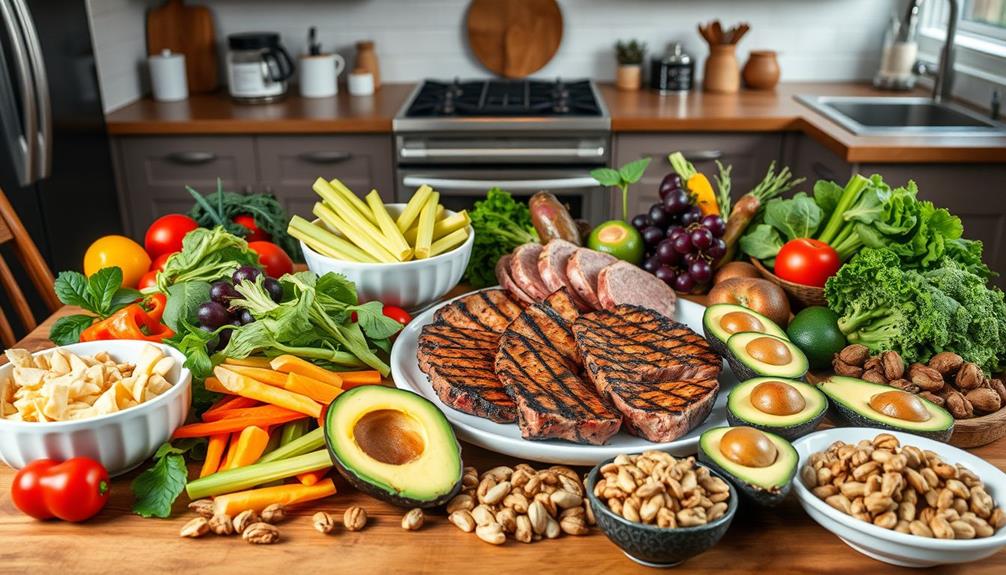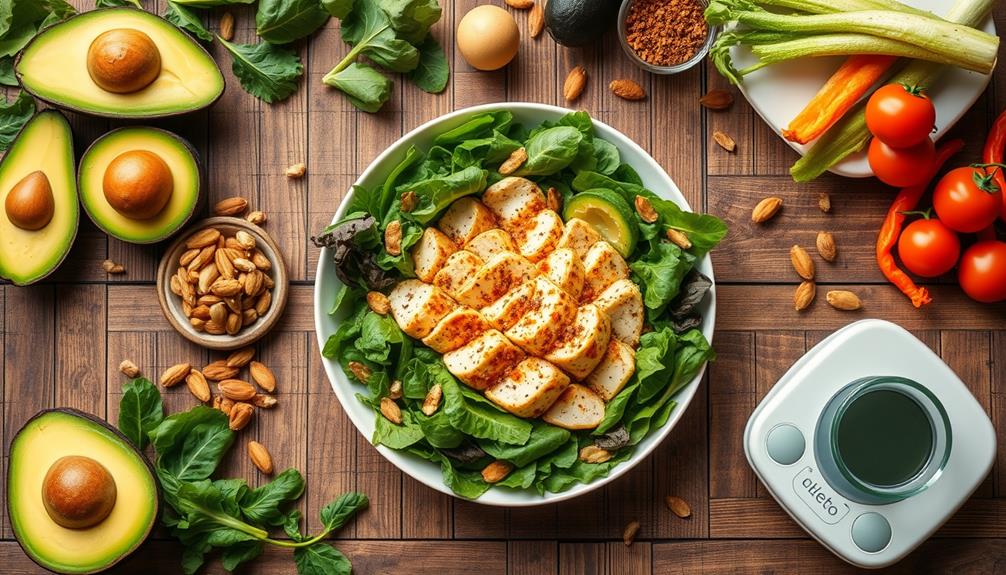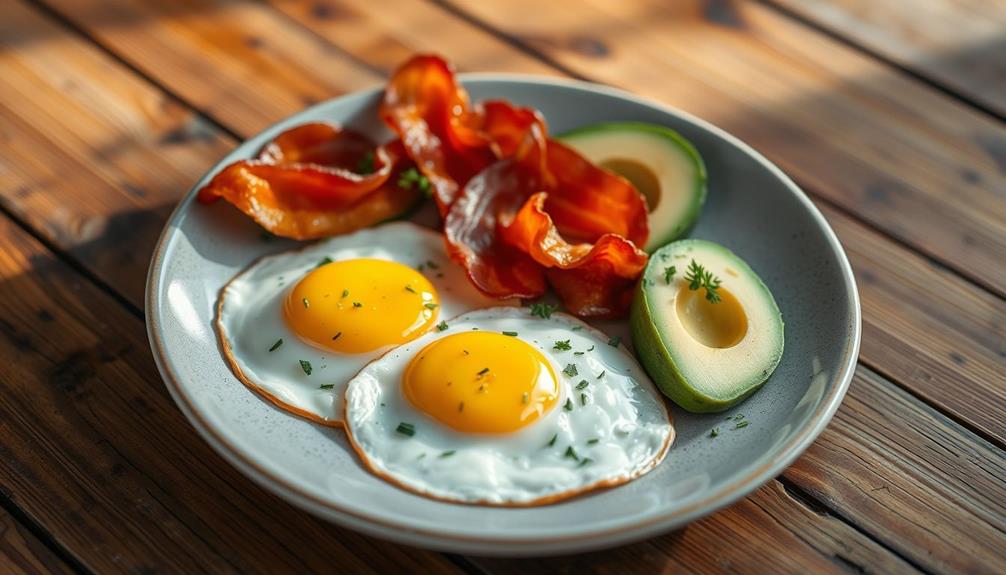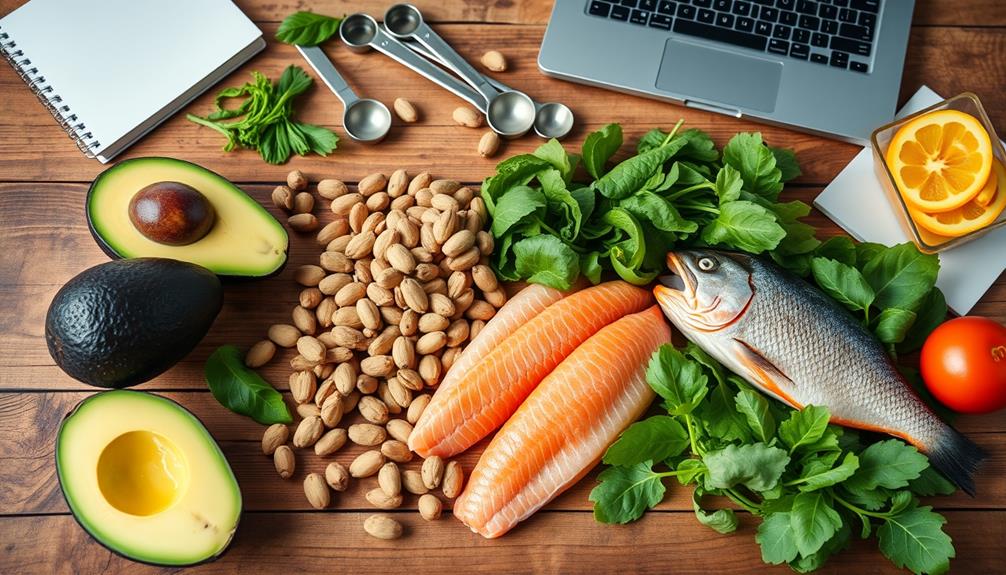To go keto, you'll need to shift your diet to include about 70% fats, 20% protein, and limit carbs to 20-50 grams a day. Start eating high-fat foods like avocados, nuts, and olive oil while avoiding sugary and starchy items like bread and pasta. Stay hydrated and focus on maintaining your electrolyte balance to minimize side effects during the changeover. Meal prep is key for success, helping you stay organized and stick to your plan. By embracing this lifestyle, you'll enhance energy and clarity. Discover additional strategies to keep your journey sustainable and fulfilling.
Key Takeaways
- Follow a high-fat, low-carb diet, aiming for 70% fat, 20% protein, and 10% carbohydrates to achieve ketosis.
- Include nutrient-dense low-carb vegetables like spinach and broccoli while avoiding sugary and starchy foods.
- Stay hydrated and maintain electrolyte balance to manage potential side effects during the dietary transition.
- Plan meals in advance and keep keto-friendly snacks available to manage hunger and maintain variety.
- Join online communities and utilize apps for support, meal planning, and tracking macronutrient intake.
Understanding the Ketogenic Diet

When you plunge into the ketogenic diet, you're embracing a high-fat, low-carbohydrate eating plan that aims to transform your body's energy source. Typically, this involves consuming around 70% fat, 20% protein, and only 10% carbohydrates. By drastically reducing your carbohydrate intake to about 20-50 grams per day, you encourage your body to enter a metabolic state known as ketosis.
In ketosis, your liver produces ketones, which serve as an alternative energy source, leading to significant changes in how your body functions. It's vital to acknowledge that maintaining proper hydration levels is essential during this shift, as the body may experience some initial gastrointestinal discomfort similar to those seen in juice diets.
As you navigate this high-fat diet, you'll need to focus on food sources like fatty meats, fish, eggs, dairy products, non-starchy vegetables, and healthy fats such as avocados and nuts.
However, be prepared to avoid sugars, grains, and most fruits, as these foods can derail your efforts to maintain ketosis. While the ketogenic diet can offer health benefits, including weight loss and improved insulin sensitivity, it's imperative to recognize potential dietary restrictions and risks, such as nutrient deficiencies and increased cholesterol levels.
Always consult healthcare professionals before starting this diet to make sure it aligns with your health needs.
Benefits of Going Keto

Embracing the ketogenic diet offers a multitude of benefits that can transform your health and well-being. One of the most noticeable advantages is significant initial weight loss. Studies show you might lose an average of 2 pounds more than those on low-fat diets within the first few months.
Improved blood sugar control is another key benefit; around 60% of type 2 diabetes patients have reversed their condition after following this diet. Additionally, adopting a keto lifestyle can lead to better overall heart health, as seen in studies highlighting its impact on cholesterol levels.
As your body adapts to ketosis, you'll likely experience increased energy levels and enhanced mental clarity. This happens because fat becomes your primary energy source, allowing you to feel more alert and focused.
Additionally, the ketogenic diet has been shown to reduce the frequency of seizures in epilepsy patients, particularly those who haven't responded well to traditional medications.
Lastly, research suggests that the keto diet may improve cholesterol levels by lowering triglycerides and increasing HDL cholesterol, which contributes to better overall heart health.
Foods to Include and Avoid

When you're following a keto diet, it's essential to focus on high-fat foods like avocados, nuts, and olive oil while keeping your carbs low with non-starchy veggies.
Incorporating balanced diet principles can further enhance your overall health.
You'll need to eliminate sugary snacks, grains, and most fruits to stay on track.
Understanding what to include and what to avoid will help you maintain ketosis and achieve your health goals.
Recommended High-Fat Foods
A successful ketogenic diet hinges on your food choices, particularly when it comes to high-fat options. To effectively promote ketosis, aim for a daily fat intake of around 70-80% of your total calories. High-fat foods like avocados, olive oil, coconut oil, nuts, seeds, fatty fish, and full-fat dairy products should be staples in your diet. These foods provide essential fats and nutrients while keeping your carbohydrate intake low.
Additionally, understanding the caffeine content in various beverages can help you make informed choices, especially if you're incorporating coffee into your keto lifestyle; consider exploring different brewing methods to optimize your coffee experience without adding unnecessary carbs.
It's crucial to limit carbohydrates to about 5-10% of your total calories. Avoid bread, pasta, rice, sugary snacks, and most fruits, with the exception of berries, as they can undermine your efforts to enter and maintain ketosis.
Protein intake should account for 20-25% of your daily calories, so choose your protein sources wisely. Incorporating non-starchy vegetables like spinach, kale, and broccoli into your meals can help you stay full and provide essential vitamins and fiber.
Always monitor food labels for hidden sugars and carbohydrates, as processed foods can disrupt ketosis. With the right high-fat foods, you can find that keto diet help you need to succeed on your journey.
Low-Carb Vegetable Choices
In the journey of adopting a ketogenic diet, selecting the right low-carb vegetables is essential for staying within your carbohydrate limits. Focus on incorporating low-carb vegetables that are nutrient-dense yet low in net carbs.
Leafy greens like spinach, kale, and lettuce are excellent choices, along with cruciferous vegetables such as broccoli, cauliflower, and Brussels sprouts. For added health benefits, consider incorporating essential oils like essential oils for respiratory health into your routine, which can support overall wellness. These non-starchy options typically contain about 2-4 grams of net carbs per serving, making them perfect for your ketogenic meal plan.
When planning your meals, aim to limit your total carbohydrate intake to 20-50 grams per day. This means you'll want to be mindful of the vegetables to avoid, including starchy options like potatoes, sweet potatoes, corn, and peas.
High-sugar vegetables like carrots and beets can also spike carb intake and should be limited.
Foods to Eliminate
To succeed on a keto diet, you'll need to eliminate certain foods that can sabotage your progress. These foods are typically high in carbohydrates and can prevent your body from entering ketosis.
Understanding your financial health is essential, as managing your budget can also help you afford healthier food options. Here are the key categories to avoid:
- Sugary Foods: This includes sodas, fruit juices, cakes, and candies. They spike insulin levels and hinder ketosis.
- Grains and Starchy Foods: Bread, rice, pasta, and potatoes are all high in carbohydrates. Consuming these will disrupt your body's shift to burning fat for fuel.
- Most Fruits: While berries can be consumed in small portions, most fruits contain high sugar levels that can impede ketosis.
- Legumes and Root Vegetables: Beans, lentils, carrots, and beets are carbohydrate-dense and should be avoided to maintain low carb intake.
Meal Planning Strategies

Effective meal planning is essential for successfully adhering to a keto diet. Start by planning your meals in advance, guaranteeing you focus on high-fat foods that make up 70% of your macronutrient intake, with 20% protein and just 10% carbohydrates. Familiarize yourself with food labels and invest in a food scale to accurately track your daily carb limits, aiming for 20-50 grams.
Additionally, incorporating yoga practices can help manage stress, which may support your dietary goals.
Utilize meal prep techniques like batch cooking and portioning to streamline your week. Preparing meals ahead reduces the likelihood of reaching for high-carb options during busy days. Explore keto-friendly recipes to create a diverse menu that keeps things interesting and enjoyable. This not only helps you stick to your plan but also guarantees you won't feel deprived.
Don't forget to keep keto snacks handy, such as nuts, cheese, or hard-boiled eggs. These can help manage hunger between meals while keeping you within your carb limits.
Managing Side Effects

Steering through the initial phases of a keto diet can sometimes lead to side effects commonly known as "keto flu." Symptoms like fatigue and headaches can be bothersome, but you can ease them by staying well-hydrated and incorporating electrolytes such as sodium and potassium into your meals.
Individuals with emotional dysregulation, similar to those with Borderline Personality Disorder, may find that dietary changes can impact their mood and overall well-being. To manage these side effects effectively, consider the following:
- Hydration: Drink plenty of water throughout the day to help combat fatigue and headaches.
- Gradual Shift: Move to a ketogenic diet slowly to allow your body to adapt to ketosis, minimizing side effects.
- Healthy Fats: Focus on consuming adequate amounts of healthy fats and maintain a moderate protein intake to prevent digestive issues like constipation or diarrhea.
- Monitor Symptoms: Keep track of your body's response during the adaptation phase; side effects usually resolve within 3-4 weeks.
If you experience severe side effects or symptoms persist beyond this adaptation phase, it's vital to consult a healthcare professional. They can help confirm the diet suits your individual health needs and guide you on how to navigate any challenges effectively.
Importance of Electrolytes

When you start the keto diet, maintaining your electrolyte balance becomes essential.
It's important to recognize that the dietary changes can greatly impact your body's nutrient levels, similar to the way caregivers must consider financial and emotional support for the elderly financial considerations for elderly care.
You might experience symptoms like fatigue or muscle cramps if you don't get enough sodium, potassium, and magnesium.
To avoid these issues, it's important to know where to find these electrolytes and how to incorporate them into your meals.
Electrolyte Imbalance Symptoms
Electrolyte imbalances are a common concern for many people starting the ketogenic diet. As your body adapts to ketosis, it excretes more water and electrolytes, raising the risk of deficiencies, particularly in sodium, potassium, and magnesium.
Recognizing the symptoms of an electrolyte imbalance can help you manage your hydration and overall well-being during this shift. Additionally, maintaining a positive mindset, akin to the abundance mindset, can be beneficial as you navigate dietary changes and their effects on your body.
Here are some key symptoms to watch for:
- Headaches: Often a sign of dehydration and low sodium levels.
- Fatigue: A drop in potassium can leave you feeling drained.
- Muscle cramps: Low magnesium levels can lead to painful muscle contractions.
- Dizziness or irregular heartbeats: These symptoms may indicate severe imbalances.
To combat these issues, guarantee adequate intake of electrolytes through your diet. Incorporate foods rich in sodium (like broth), potassium (such as avocados), and magnesium (found in nuts).
Additionally, prioritize hydration by increasing your water intake. Monitoring your electrolyte levels and adjusting your intake accordingly can greatly enhance your comfort and energy during the adaptation phase of the keto diet.
Sources of Electrolytes
Maintaining proper electrolyte levels is vital for your overall health, especially on the ketogenic diet. As your body adapts to ketosis, you'll need to focus on replenishing electrolytes like sodium, potassium, and magnesium. A notable drop in carbohydrate intake can lead to increased water and electrolyte loss, making it essential to avoid symptoms of the "keto flu" such as fatigue and cramping.
To guarantee you're meeting your daily electrolyte needs, incorporate keto-friendly foods into your diet. Avocados are a fantastic source of potassium, while leafy greens like spinach provide magnesium.
Don't forget about sodium; adding salt to your meals can help maintain your levels.
For some individuals, supplementation may be necessary, particularly for potassium and magnesium, as these minerals can be harder to obtain in sufficient amounts from food alone.
Staying hydrated is equally important. Proper hydration, combined with monitoring your electrolyte levels, can greatly enhance your well-being and energy during this shift.
Long-Term Sustainability

The ketogenic diet's long-term sustainability can pose significant challenges due to its restrictive nature, often making it tough to stick with. Many people find it difficult to maintain long-term weight loss on a restrictive diet, which can lead to weight regain once they return to a regular eating pattern.
However, you can enhance your chances of success by focusing on a few key strategies:
- Incorporate Variety: Include a range of keto-friendly foods like low-carb vegetables, healthy fats, and high-quality proteins to maintain interest and nutritional balance.
- Flexible Approaches: Consider shifting to a cyclical or targeted ketogenic diet, allowing for occasional higher-carb days or increased carb intake around workouts.
- Monitor Health Markers: Regularly check your cholesterol levels and nutrient intake to mitigate potential risks from high saturated fat consumption.
- Join a Supportive Community: Engaging with others on the same journey can provide motivation and accountability, making it easier to stick with a sustainable keto lifestyle.
Common Misconceptions

Keto dieting often comes with a slew of misconceptions that can mislead newcomers. One common belief is that you can eat unlimited fat, but the ketogenic diet requires a careful balance of macronutrients—typically around 70% fat, 20% protein, and 10% carbs. Many also think all low-carb diets are the same as keto, but the ketogenic diet aims to keep carbs restricted to 20-50 grams daily to put your body in a state of ketosis.
Here's a quick overview of some common misconceptions:
| Misconception | Reality |
|---|---|
| Unlimited fat consumption is allowed | Requires a balanced intake of macronutrients |
| Keto is suitable for everyone | Not ideal for those with certain health conditions |
| It's a long-term solution for weight loss | Primarily effective for short-term results |
Lastly, many believe they can return to regular eating after reaching their weight loss goals. This often leads to rapid weight regain unless you make sustainable dietary changes. Being aware of these misconceptions can help you navigate the ketogenic diet more effectively.
Tips for Success

To succeed on the keto diet, effective meal planning and proper hydration are essential.
You'll want to prepare meals in advance, focusing on high-fat, low-carb foods to stay on track.
Don't forget to keep your electrolytes balanced by staying hydrated and increasing your salt intake, as this can help mitigate some common side effects.
Meal Planning Strategies
Effective meal planning is essential for anyone looking to succeed on a keto diet, as it helps you stay organized and committed. By preparing meals in advance, you can guarantee you have keto-friendly options available, focusing on high-fat foods while avoiding high-carb items.
Here are some strategies to enhance your meal planning:
- Create a Weekly Meal Plan: Outline your meals to include high-fat foods like avocados, nuts, and fatty fish. This keeps you within your carb limit of 20-50 grams per day.
- Familiarize Yourself with Food Labels: Identify hidden carbohydrates in packaged foods to avoid unnecessary carbs that could hinder your ketosis.
- Utilize Meal Prep Techniques: Cook large batches of keto meals to simplify your cooking routine and reduce the temptation to indulge in non-keto foods.
- Stock Up on Keto-Friendly Snacks: Keep snacks like cheese, olives, and hard-boiled eggs handy to manage hunger and prevent cravings for high-carb options.
Also, incorporate a variety of low-carb vegetables to add volume and nutrients to your meals without exceeding your carb limits.
With these strategies, you'll set yourself up for keto success!
Hydration and Electrolyte Balance
Staying properly hydrated and maintaining electrolyte balance is essential for your success on the ketogenic diet. During the initial phase, your body may lose more water, leading to dehydration. To combat this, aim to drink at least 8-10 cups of water daily.
To guarantee you're getting enough sodium, potassium, and magnesium—key minerals that can deplete during ketosis—consider incorporating electrolyte supplements or consuming bone broth. Here's a quick guide to help you track your intake:
| Electrolyte | Recommended Daily Intake | Food Sources |
|---|---|---|
| Sodium | 3,000-5,000 mg | Sea salt, broth |
| Potassium | 2,500-4,700 mg | Avocados, leafy greens |
| Magnesium | 310-420 mg | Nuts, seeds, dark chocolate |
Keep an eye out for signs of imbalance like fatigue, muscle cramps, dizziness, or headaches. If you notice these symptoms, adjust your fluid intake and consider boosting your mineral consumption. Prioritizing hydration and electrolyte balance will enhance your overall keto experience.
Resources for Support

Finding support on your keto journey can make all the difference in staying committed and motivated. Connecting with others who share your goals enhances your experience and provides valuable resources. Here are some ways you can find support:
- Online Platforms: Join dedicated keto communities on Reddit and Facebook. These platforms are great for sharing recipes, personal experiences, and tips on the ketogenic diet.
- Websites: Utilize resources like DietDoctor.com and Ruled.me. They offer extensive meal plans and keto recipes tailored to various dietary preferences, ensuring you stay on track.
- Mobile Apps: Download apps such as Carb Manager and MyFitnessPal. These tools help you track your macronutrient intake, making it easier to adhere to the strict carb limits of the keto diet.
- Local Support Groups: Look for meetups in your area. Engaging with support groups fosters a sense of community and provides the encouragement and accountability you need.
Additionally, reputable health organizations like the Mayo Clinic and Cleveland Clinic offer evidence-based information on safely implementing the ketogenic diet.
Frequently Asked Questions
How Do I Start My Keto Diet for the First Time?
To start your keto diet, calculate your daily macronutrient targets, eliminate high-carb foods, and incorporate healthy fats. Stay hydrated, prep meals, and track your intake to maintain ketosis and avoid cravings. Remember to focus on whole, nutrient-dense foods while following the keto diet, and experiment with different recipes and meal combinations to keep things interesting. Additionally, prioritizing quality sleep and managing stress can also support your keto journey. These keto diet tips can help you stay on track and achieve your health and weight loss goals.
What Are the 9 Rules of Keto?
Imagine a treasure map guiding you through the keto jungle. To navigate, stick to these nine rules: limit carbs, embrace healthy fats, moderate protein, stay hydrated, balance electrolytes, and always plan your meals ahead.
How Do Beginners Get Into Ketosis?
To get into ketosis, you'll need to drastically cut carbs, boost healthy fats, and moderate protein. Staying hydrated and tracking your food intake can help you navigate the initial adaptation phase effectively.
How to Jump Start a Keto Diet?
To jump-start your keto diet, limit carbs to 20-50 grams daily. Focus on high-fat foods, stay hydrated, and plan meals ahead. Gradually reduce carbs to help your body adjust smoothly during this shift.
Conclusion
Going keto can feel like discovering a hidden path in a dense forest; it opens up a world of energy and clarity. By understanding the diet, planning meals, and managing side effects, you can thrive on this journey. Remember, it's not just about cutting carbs but embracing a new lifestyle. Stay informed, stay committed, and don't hesitate to seek support. With the right mindset, you'll find success and enjoy the benefits that come with it.









